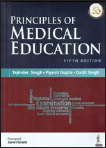Translate this page into:
Principles of Medical Education
Corresponding Author:
Anu Thukral
Department of Paediatrics, All India Institute of Medical Sciences, New Delhi
India
dranuthukral@gmail.com
| How to cite this article: Thukral A. Principles of Medical Education. Natl Med J India 2021;34:117 |

Principles of Medical Education (Fifth edition). Tejinder Singh, Piyush Gupta, Daljit Singh (eds). Jaypee Brothers Medical Publishers (P) Ltd., New Delhi, 2021. 248pp, price not mentioned. ISBN 978–93–90281–41–1.
This book is aimed at guiding medical teachers both at the entry-level and those who conduct faculty development programmes about the requirements of a good teacher and provides them a lucid conversational style making them think about their respec-tive teaching strategies.
It starts with the basic principles of teaching and learning, talks about the role of a system's approach and highlights that assessment is a part and parcel of educational design. It systematically covers the fundamental aspects of any curriculum and the prerequisites for the delivery of a good lecture. Each topic in the book starts with learning objectives and day-to-day examples and then proceeds step-by-step. The writing style is geared to help a better understanding of the topics.
The strengths of the book include the focus on methods of assessment. The effective and efficient delivery of healthcare warrants analytical and communication skills, counselling and evidence- and system-based care, in addition to basic knowledge. Thus, the assessment systems need to be comprehensive, sound and robust enough to assess the requisite attributes. It speaks about workplace-based assessment as a complement to observed structured clinical examination for skills and procedures as well as observed structured long case record for traditional long case presentation.
A unique feature of this book is that it is written from the perspective of a medical teacher and covers the different scenarios starting from conventional learning and going up to innovative teaching–learning methods. It explains the concept of distance education, problem-based learning and e-learning.
These are turbulent times both for the teacher and the learner. However, they are exciting too, since many avenues for learning have opened up at every level. Virtual education has opened up possibilities of rethinking the way of teaching and learning. Use of new tools can transform the virtual classroom, but most of it still depends on the creative ability of the teacher. This book also gives an example of possible teaching–learning innovative methods, thus perfectly addressing the current changing needs.
Overall, it is an excellent resource with simple succinct ideas. The quality of production and the legibility of the typeface are excellent.
This book will serve as a good supplement to a medical teacher and deserves a place in the library of any medical teacher who wishes to be updated and wishes to self-reflect on the ways of teaching.
Fulltext Views
2,916
PDF downloads
2,274




